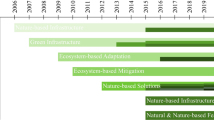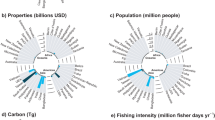Abstract
Sustaining healthy coastal ecosystems that provide for people dependent on their goods and services requires good resource management. The research presented in this book can help enhance resource management in the three theme areas, specifically in terms of providing better information on (1) how to value marine and coastal ecosystems, (2) how these values are affected by economic activity in the form of harvesting and land transformation, and (3) the design of institutions to provide for sustainable livelihoods and resources. The papers in this volume also point to research and knowledge gaps and, hence, opportunities to fill them. The book is very much a beginning rather than an end in terms of our understanding of the complexities of our natural environment and how best to ensure that it will continue to provide the essential goods and services that the planet needs to survive.
Access provided by Autonomous University of Puebla. Download chapter PDF
Similar content being viewed by others
Keywords
These keywords were added by machine and not by the authors. This process is experimental and the keywords may be updated as the learning algorithm improves.
Sustaining healthy coastal ecosystems that provide for people dependent on their goods and services requires good resource management. The research presented in this book can help enhance resource management in the three theme areas, specifically in terms of providing better information on (1) how to value marine and coastal ecosystems, (2) how these values are affected by economic activity in the form of harvesting and land transformation, and (3) the design of institutions to provide for sustainable livelihoods and resources. The papers in this volume also point to research and knowledge gaps and, hence, opportunities to fill them. The book is very much a beginning rather than an end in terms of our understanding of the complexities of our natural environment and how best to ensure that it will continue to provide the essential goods and services that the planet needs to survive.
The papers in the first section provide detailed descriptions of the methods economists use to measure the value of ecosystems to society. These include a variety of forms of stated preference frameworks, i.e., contingent valuation methods and choice experiments as well as revealed preferences in the form of travel cost estimations. The papers find that there is a large variation in the willingness to pay for ecosystem goods and services, dependent primarily on two things: who is being asked to pay and for what.
The findings suggest that the more closely the respondents engage with the ecosystem in question (e.g., tourists enjoying the benefits of a beach or diving and snorkeling on a reef), the higher the willingness to pay. When local inhabitants are asked to help protect a species at risk (e.g., whale sharks or turtles), willingness to pay is not very high. These results suggest that income constraints matter, as we would expect from economic theory. People whose income levels are not high cannot think about allocating their scarce funds for the protection of species from which they may get psychic value but no consumption or commercial value. Respondents also signal that these resources are shared goods and that there needs to be a way to have a broader swath of society pay to protect them. This is one of the conundrums with willingness to pay estimation and payments for ecosystem services—will people actually pay what they have stated? How would governments collect these amounts? And how could they be converted into payments for protecting and enhancing ecosystem services?
The problem of providing public goods (or reducing public “bads”) remains a challenging issue in economic analysis and public policy practice. Some of the papers provide examples of feasible mechanisms for collecting more of users’ consumer surplus (e.g., charging higher user fees at tourist sites), but how to sustain species and their ecosystems when there is no readily identifiable user that can be charged a fee remains a broader challenge. The papers provide fulsome methodological analysis of real cases where ecosystems and livelihoods can be at risk. Future research could be directed to see what has happened in these cases—was there any follow up to the issues explored in these papers? Were any new or incremental fees introduced? Were other policies explored in addition to fees and taxes? What sort of attention did their work receive that may lead to better management of the natural environments they investigated?
The second section deals much more explicitly with how to improve upon the management of coastal and marine environments. While the papers are quite different, ranging from cost-benefit studies of coastal development to assessment of policies designed to sustain fisheries (both capture and aquaculture); there are cautionary tales in each. These tales provide clear examples of policy failures combined with thorough analysis of policy initiatives that could reduce environmental damages while improving local livelihoods. Viable policies are analyzed in these studies to improve water quality and, in turn, fish harvest in Songkhla Lake; reduce aquaculture stocking levels in the Philippines; improve the management of fish pond licenses and restore abandoned ponds to mangroves or other uses; and assess the impacts of coastal development on ecosystem sustainability.
Each study provides a set of pragmatic approaches that decision makers can use to identify the trade-offs between economic activities and their ecosystem impacts, for example, using cost-benefit analysis, institutional and detailed field studies, and in-depth interviews with those affected. They follow up this discovery with an analysis of policies designed to mitigate trade-offs. The studies illustrate the value of undertaking careful economic and policy analysis, not just to identify problems but also to help solve them.
The third set of papers continues with the evaluation of existing policies and design of potential policies to improve coastal resource management. These are focused on fisheries that operate in an open access environment, where there are no or few specific property rights to the harvest and where fishers are predominately artisanal and low income. Hence, policy makers have to balance the need to sustain fish stocks, which could be done by significantly reducing fishing effort, with the need to sustain the livelihoods and incomes of fishing communities.
The policies explored in these papers highlight the trade-offs. For instance, a marine protected area (MPA) can help enhance the sustainability of aquatic species and their ecosystem, but at the expense of reducing the amount of fish available for harvest by the local fishers. This creates tension between regulators and the community and therefore motivates illegal harvesting.
The findings in the three papers dealing with protected areas are similar: better outcomes with fewer trade-offs are observed the greater the role of the community in decision making with regard to regulations and their enforcement. Engagement with fishers can enhance the understanding of the goals of the policy, improve enforcement and usage of proper gear type, and assist in the management of the protected area boundaries and fishing seasons. A rich set of policies in addition to MPAs are explored—individual quotas, individual transferable quotas, artificial reefs, and the use of the power of the market, through the supply chain and the consumer demand for sustainable fisheries, to impose size restrictions on harvests. Each study illustrates how good policy design can enhance the fishers’ well-being while better protecting fish stocks.
The papers also demonstrate that research quality and relevance are enhanced by going into the field to interview fishers, to go out on their vessels, and to engage them in an experiment. These help researchers understand fishers’ constraints and concerns. Similar value is obtained by talking to the regulators. These studies illustrate what sorts of policies improve the likelihood of a mutually sustainable economy and environment and can serve as important examples for fisheries in many parts of the world.
The volume thus provides in-depth studies of the challenges of using our natural environment to sustain livelihoods without destroying the very ecosystems that provide the goods and services. They offer methodologies for exploring benefits to society that could be obtained with effective resource management. Some provide analysis of public policies to address the conflicts and trade-offs that arise in natural resource use. The richness of the local cases, which provide detailed descriptions of the affected communities, institutions and regulations, and consumers of the ecosystem goods and services, provides future researchers with a good base, not only for case comparisons but also for methodological treatment.
The lessons learned in these studies can be applied to other jurisdictions beyond Southeast Asia. They can help improve our understanding of how to better manage our interaction with and dependence on our natural environment. However, much more remains to be done. Some of the studies are now more than 10 years old. What has happened since these studies were first done? Did the research affect policy? What has happened to the natural resource and the people dependent upon it? More time has passed since the introduction of, for example, MPAs, gear restrictions, better accounting for fish pond licenses, and perhaps higher user fees for tourists. In our view, there aren’t enough longitudinal studies of natural resource management and use. Research methodologies have advanced in some cases—more sophisticated econometric analysis and controlled experimental design to name two. Going back to a case where there is a baseline provided by the researchers in this volume could be very illuminating.
These cases are, by design, focused on the economic aspects of coastal marine management. Biological and biophysical data is always a challenge and often these studies have had to infer underlying conditions. Better data would benefit the analysis. For example, more work is needed on the interplay between exogenous (to local communities) factors such as climate change, local and global pollutants (e.g., plastics, marine “dead zones,” toxic blooms, etc.), and resource management.
Finally, in updating any of these cases or exploring analogous ones in other regions, we need more fulsome policy analysis. Such analysis should explore different means of achieving sustainable resource management using criteria in addition to efficiency and equity. The cases in this volume provide sound foundation for the examination of the complexities of coastal management. The problems they identify are endemic to jurisdictions worldwide. We need ongoing analysis of how to address these problems with examples of what works and doesn’t work. The marine environment is crucial to the planet’s survival; we have to persist in understanding how humans can use the environment without destroying it.
Author information
Authors and Affiliations
Corresponding author
Editor information
Editors and Affiliations
Rights and permissions
Copyright information
© 2016 Springer Science+Business Media Singapore
About this chapter
Cite this chapter
Olewiler, N. (2016). Conclusion: What We Have Learned. In: Olewiler, N., Francisco, H., Ferrer, A. (eds) Marine and Coastal Ecosystem Valuation, Institutions, and Policy in Southeast Asia. Springer, Singapore. https://doi.org/10.1007/978-981-10-0141-3_18
Download citation
DOI: https://doi.org/10.1007/978-981-10-0141-3_18
Published:
Publisher Name: Springer, Singapore
Print ISBN: 978-981-10-0139-0
Online ISBN: 978-981-10-0141-3
eBook Packages: Economics and FinanceEconomics and Finance (R0)




